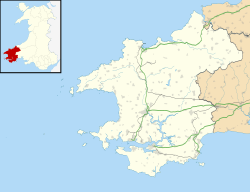History
Evidence of prehistoric occupation can be seen by the remains of fortifications at Penralltddu, a scheduled monument, and at Castell Felinganol (or Castellfelorganol). [2]
The name of the hamlet is assumed to derive from the 5th century saint, Illtyd, to whom the parish church is now dedicated. Church records date back to 1674, and the parish was in the Hundred of Kilgerran (formed in 1536) [3] even though it was in the Cemais administrative area. [4] The region was occupied by the Normans in the 12th century, who built castles at several strategic locations in the area; the clear remains of a motte and bailey exists at Castell Penyrallt (or Castell Pen-yr-allt). [2] A clergyman in 1864 remembered stonework on the latter, but this was no longer evident at the time of the 1925 Royal Commission. [5] The Norman structure may have reused a prehistoric fort. [6]
The name of the parish church was Langetot in the Taxatio of 1293, as Langettod in the St David's episcopal register of 1513, and appears on a 1578 parish map of Pembrokeshire as Llantwood. [7] The attachment to St Illtyd may therefore be of later origin. [5]
In 1870, Llantwyd was listed in Wilson's Gazetteer as consisting of 1,792 acres (725 ha), 61 houses and a population of 264. [8]
This page is based on this
Wikipedia article Text is available under the
CC BY-SA 4.0 license; additional terms may apply.
Images, videos and audio are available under their respective licenses.


